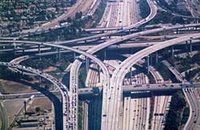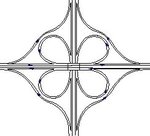Road junction
|
|
In the field of road transport, a road junction is a place where two or more roads either meet or cross. The main types of road junctions are intersections and interchanges. A road junction may also be called a crossroads. A junction between 3 road segments (arms) is a T junction (two arms form one road) or a Y-junction.
| Contents |
Terminology
Note: The descriptions of road junctions are for countries where vehicles drive on the right side of the road. For countries where driving is on the left the layout of the junctions is the same, only left/right is reversed.
A higway ramp (as in exit ramp and entrance ramp) or slip road is a short section of road which allows vehicles to enter or exit a freeway (motorway).
- A directional ramp always tends toward the desired direction of travel. This means that a ramp that makes a left turn exits from the left side of the roadway (a left exit). Left directional ramps are relatively uncommon as the left lane is usually reserved for high-speed through traffic. Right ramps are almost always directional.
- A non-directional ramp goes in a direction opposite to the desired direction of travel. Many loop ramps (as in a cloverleaf) are non-directional.
- A semi-directional ramp exits a road in a direction opposite from the desired direction of travel, but then turns toward the desired direction of travel. Many 'flyover ramps' (as in a stack) are semi-directional.
- A U-Turn ramp leaves the road in one driving direction, turns over it and rejoins in the opposite direction.
Weaving is an undesirable situation in which traffic veering right and traffic veering left must cross paths within a limited distance, to merge with traffic on the through lane. Weaving creates both safety and capacity problems. Some areas that had such junctions have gone through the expensive process of "unweaving the weave" to improve traffic flow.
The German Autobahn system splits Autobahn-to-Autobahn interchanges into two types - Autobahnkreuz (AK, translates as motorway cross), a crossing of two Autobahns (or something more complicated), and Autobahndreieck (AD, translates as motorway triangle), an interchange where one of the Autobahns ends.
Intersections
Intersection_4way_overview.jpg
Intersection_4way_from_car.jpg
Intersection_4way_pedestria.jpg
An intersection is a road junction at which roads meet at grade. Types of intersections include:
- Uncontrolled intersections, without signs or signals (or sometimes with a warning sign). On a 4-way intersection traffic from the right has priority; on a 3-way intersection rules may vary by country: either traffic from the right has priority again, or traffic on the continuing road. For traffic coming from the same or opposite direction, that which goes straight has priority over that which turns off.
- Yield-controlled intersections may or may not have specific "YIELD" signs (known as "GIVE WAY" signs in some countries).
- Stop-controlled intersections have one or more "STOP" signs. Two-way and four-way stops are common.
- Signal-controlled intersections depend on traffic signals, usually electric, which indicate which traffic has the right-of-way at any particular time.
- A traffic circle is a special type of intersection at which traffic streams are directed around a circle. Types of traffic circles include roundabouts, 'mini-roundabouts', 'rotaries', "STOP"-controlled circles, and signal-controlled circles. Some people consider roundabouts to be a distinct type of intersection from traffic circles (with the distinction based on certain differences in size and engineering).
- A box junction can be added to an intersection, generally prohibiting entry to the intersection unless the exit is clear.
- While not a specific type of intersection, the US state of Michigan frequently employs a special arrangement for making left turns, known as a Michigan left. These are generally used in conjunction with Signal-controlled intersections, although it can also apply to Stop-controlled intersections.
Interchanges
A highway interchange is a road junction that utilizes grade separation, and one or more ramps, to permit traffic on at least one road to pass through the junction without crossing any other traffic stream. A complete interchange has enough ramps to provide access from any direction of any road in the junction to any direction of any other road in the junction.
Barring u-turns, a complete interchange between two freeways requires eight ramps, while a complete interchange between a freeway and another road (not a freeway) requires at least four ramps. Using u-turns these numbers can be halved to four and two respectively, by making cars that want to turn left pass by the other road first, then make a u-turn and turn right. The use of u-turn ramps is common in less wealthy countries.
The general rule today is that freeways should have at least one mile between interchanges to prevent excessive weaving between entering and leaving traffic. Unfortunately, most older freeway interchanges do not follow this rule (and are congested as a result).
Types of interchanges between two freeways
- A cloverleaf is a two-level interchange in which left turns are handled by loop ramps. To go left, vehicles first pass either over or under the other road, then bear right onto a one-way ramp that loops 270 degrees to the right and then merges onto the intersecting road. (In countries where cars drive on the left, this would be a right turn.) The major advantage of cloverleafs is that they require only one bridge, which makes such junctions cheap if land is plentiful. A major problem with cloverleafs is weaving (see definition of weaving, above). Cloverleafs also have a considerable land consumption which means that while they are common in the United States, Germany, and Netherlands, only three such junctions are found in the short-of-land United Kingdom, none on the motorway network. In Germany the standard design is to separate all turning traffic into a parallel lane so that the extra road space minimizes the problem of weaving.
Stackedjunction.jpeg

- A stack is an interchange in which left turns are handled by semi-directional flyover ramps. In order to go left, vehicles first turn slightly right (on a 'right-turn' ramp), then go left on a ramp which goes over (or under) both freeways and connects to the 'right-turn' ramp in the opposite quadrant of the interchange. A stack interchange, then, has two pairs of left-turning ramps, which can be "stacked" in various configurations above or below the two through routes. Stacks do not suffer from the problem of weaving associated with cloverleafs, but require massive construction works. A basic stack involves roads on four levels, but in stacks including ramps for direct movement between high occupancy vehicle lanes, even more levels of stack can be needed. This is not only expensive, but also unsightly leading to considerable NIMBY opposition.
An alternative to the stack which requires fewer levels while retaining semi-directional ramps throughout has the left-turning ramps sweep around the center of the interchange in a spiral pattern. This has slightly less capacity because the ramps turn and change height more quickly. One example of a freeway-to-surface street ramp in this style would be the Interstate 696/Mound Road interchange in Warren, Michigan.
- A cloverstack (half cloverleaf, half stack) is an interchange in which left turns are handled by two loop ramps and two semi-directional flyover ramps. The cloverleafs will be opposite each other. A cloverstack avoids the weaving problem associated with cloverleafs, without the expense of a full stack. Cloverleafs are sometimes converted to cloverstacks (by eliminating 2 loop ramps and replacing them with two flyover ramps). Such a conversion improves the capacity and safety of the interchange.
A variation appropriate when the freeways meet at an angle is to have cloverleafs for the sharp left turns (less than 270° turning) and adjacent semi-directional ramps for the gentle left turns, one inside and one outside the junction. This design is compact and has no serious drawbacks.
A junction with two adjacent cloverleafs is sub-optimal and will be the result of a previous junction improvement subject to land restriction.
Trumpetjunction.jpeg
- A trumpet is an interchange traditionally used where one freeway terminates at another freeway; it involves at least one loop ramp (for traffic leaving the terminating freeway) whose overpass is shared by traffic connecting to the terminating freeway. These junctions are also useful for toll roads as they concentrate all entering and leaving traffic in a single stretch of road, where toll booths can be installed.
- A Directional T provides for high-speed ramps in all directions at a three-way interchange. A semi-directional T does the same, but some of the splits and merges are switched to avoid ramps to and from the fast lane.
- Hybrids, variations and rare types
Types of interchanges between a freeway and a non-freeway road
- Diamond interchange
- Cloverleaf interchange
- Parclo interchange (partial cloverleaf - sometimes called a folded diamond when only four ramps, in two quadrants, are used)
- Single Point Urban Interchange
- Roundabout interchange - this uses a single roundabout (sometimes signal-controlled) which spans the freeway with two over/underpasses (either above or below the freeway). These are very common in the UK, Ireland and France, but almost unknown in the rest of Europe and the United States. Such junctions can be improved by adding a flyover for straight-through traffic on the non-freeway, creating a stacked roundabout.
- Dumbbell interchange - this is similar to a diamond except that it uses roundabouts rather than signals or stop signs where the ramps meet the non-freeway road.
External links
- Kurumi.com US interchanges directory (http://www.kurumi.com/roads/interchanges/)
- Chris Marshall's UK interchanges directory (http://www.cbrd.co.uk/reference/interchanges/)
- Detailed history of interchanges with diagrams, in German (http://members.a1.net/wabweb/frames/kreuzf.htm)de:Autobahnkreuz
ko:나들목 nl:Knooppunt (verkeer) ja:ジャンクション sl:Avtocestni razcep

